Thoughts from today
February 07, 2008 | CommentsDrawing out some interesting chunks of today:
- I think most presentations have referenced or been heavily based upon mobile, much more so than last year;
- The idea of community-supported teaching that Ewan McIntosh alluded to (there being only a single reviewer of classwork currently, the teacher), harked back to Sugatra Mitra's work having Indian children self-teach computer literacy;
- I'm wondering how social software should enable lies (or at least plausible deniability) and how sharing secrets might be used online as a starting point to build relationships;
- Rafi of Violet's comment that "Fun and interpersonal communication are as powerful propositions as usefulness". I sooo need to get my RFID on;
- The developing world as an audience for mobile, strangely enough tying into a presentation we had from a client regaring a product we'd built recently;
- Paul Dourish on ethnography was fascinating, I'm desperately trying to relate it to something I could practically *do*...
LIFT 2008: User Experience
February 07, 2008 | Comments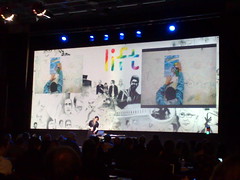 First, Younghee Jung on Nokia "Open Studio: Vision by Relevance, Design for Use"
First, Younghee Jung on Nokia "Open Studio: Vision by Relevance, Design for Use"
Telecomms is older than a century. Mobile has been around long enough for us to stop asking what it is.
Photo of an Indian girl placing her mobile phone on the altar in her house. It's the only electronics in her house, she uses it to record TV and radio. What would you design for her? What information would you need to do this?
3.1bn out of the 6.5bn people worldwide used mobiles last year. New subscribers will come from Indonesia, China, Brazil: countries undergoing vast socioeconomic changes.
What do their researchers do? Close observation in daily life, and workshop/focus group style stuff.
Nokia Open Studio was a design competition, hosted in Mumbai, Rio and Accra (Ghana). A local team in each location, recruited from the community where possible, ran things. Teams came up with slogans for the competition, promoted it with slogans, T-Shirts (in Rio).
Challenges: weather (Mumbai had its rainy season and was flooded with rain and sewage), security (the neighbourhood in Rio was often considered off-limits for outsiders thanks to gang problems), electricity (scarce in Accra).
Process: an entry form (one sheet of A3 paper), handed to participants during a visit to the studio. Illiteracy in Mumbai meant the local team had to assist. An interview helped the team understand how entries related to the entrants personal situation (rather than just being a list of functions). Then a photo-shoot of the entrants with their entry.
Winner selection: local teams explained entries in the context of their local knowledge; an award ceremony where a token outsider presented the award. These were quite big in the local community - lots of entrants brought their families along. Feedback was that entrants felt proud, thanks to their being asked what they wanted.
Entries:
- "Cloud-buddy mobile": a phone which can be pointed at the sky to check the weather, to see whether it's going to rain or not. Lots of local folks argued that this was nothing new, but it pulled through because it was felt to be intuitive to use, was entered by a woman (rare in Mumbai) and met a real need: lack of information sources like TV or radio meant that weather forecasts were hard to come by for a normal housewife.
- "Eco-Cell", a phone to measure pollution locally which was solar charged. Voted unanimously the best by the Rio team. All three communities had self-built sewage system and big pollution problems.
- "Four-star", a phone which can host 4 SIM cards to allow a user to take advantage of pricing of the 4 local operators (who all offer free/cheap calls within network). SIM switching is common here. The designer also wanted the phone to be a playstation and play cable TV too :)
Distinctive aspects that emerged from the communities:
- Mumbai: one designer wanted a speaker on the phone so he could share announcements at religous festivals. Media sharing was a common theme. Heart-shaped phones were common too (symbolising the closeness of the mobile to the individuals heart). Symbolism of shape was clearly important. Also a bottle-shaped phone to store water for drinking, that would also float in water when it's dropped. Durable, unbreakable, waterproof: these were all themes. In this community phones are kept for a very long time, it's not unusual to see keypads completely worn off.
- Rio: a bossy 11-year-old daughter wants a phone to monitor her mother. With high teenage pregnancy rates here, many mothers leave their children at home to study.
- Accra: solar powered phone with translator (designers home town had no electricity - a charging station means owners have to pay to charge their phones). Shared usage of phones was noted; removable cameras were proposed to make it easier to share a phone between a few people (I didn't quite follow why). Visual caller ID was proposed to forge stronger relationship between a child and distant parents. Another caller wanted GPS caller ID to locate his future wife and ensure she is where she says she is. Many refugees were dependent on remote relatives sending them money - and proposed second screens to ensure they never missed a call.
Why did Nokia do this? Being in a corporate design team, they're subject to time constraints - what can they learn about an environment in, say, a 2-week visit? This is all about getting a better understanding of remote unfamiliar environments, by focusing on what local individuals wants as an ideal, instead of concentrating on the present.
Entries let Nokia see a very subjective view of technology expressed by participants. They may ask for participants to design devices other than phones in future.
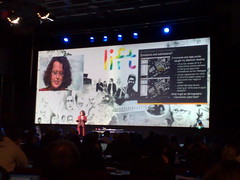 Next, Genevieve Bell, Director of User Experience at Intel: "Secrets, Liues and Digital Deceptions"
Next, Genevieve Bell, Director of User Experience at Intel: "Secrets, Liues and Digital Deceptions"
Intel has 30 anthropologists, helping orient Intel towards how people relate to their technology.
3 moments caught her attention this year:
- She locked herself out of her Flickr account by lying about her birthdate and place of birth inconsistently. She wondered who else has done this. Half of people with mobiles actively lie about where they are when texting.
- 100% of people using online dating sites lie about their height (men) and weight (women).
- James Katz: "we're entering an arms race of digital deception". For every device which purports to tell the truth (e.g. LBS) there's another to help us deceive (alibi services).
She did a fairly cheap and cheerful, global comparitive anthropological survey. Technology changes faster than people do - it hasn't transformed all of us as much as we'd like to believe. This is hard for Intel to wrap its head around.
So, secrets (knowledge we withhold) and lies (untruths).
Lying is inherently a bad thing, as we see from legal systems and religions around the world, e.g. sins of commission, sins of omission in Catholicism. In Islam, Mohammed identifies circumstances where witholding the whole truth can be positive (e.g. to keep the peace in the home). Similar proscriptions exist in Judaism. Tamil saying: "it's OK to tell a thousand lies if the wedding still happens".
Secrets are very different in different cultures: it's ambiguous. Sharing secrets generates trust. Some secrets are enshrined in concepts like national security.
Cultural practices are different to these ideals: we lie all the time (6-200 lies/day): from greasing social skids through concealing misbehaviour, increasing popularity. Men tell 20% more lies than women - women tell fewer, but better lies. Secrets on the other hand are broken and kept irrespective of religion or laws.
Some social theorists argue lying is a necessary part of daily life. It's not the opposite of truth, it's about negating the real around us. Self-deception is a part of survival, we actively repress the things we can't handle. Lies can be seen as a form of play, a way of working through identity and rules.
Freedom of information to everyone is a relatively recent notion and not one that's got much history in cultures. e.g. aboriginal cultures have an idea of secret knowledge for men and women. Witholding information keeps it "safe". What we choose to withold and why is part of a mechanism for keeping us safe.
Online we lie about location, context, intent, identity, etc. Some of this is necessary: there are many people on Myspace who are probably younger than 14. 10% of their population probably aren't over 100, as they claim: you have to lie if you're younger than 14, to get onto the service.
References postsecret.com
Mobiles have tracking services related to them. In Korea there are services that create digital alibis for you.
Early insights: there are interesting tensions between cultural ideals and practices. New technologies have the potential to tell the truth, unbidden. Is this what we want?
Do these twin ideas of secrets and lies give us new ways of thinking about privacy and security?
Shows a photo of a sign, pointing out that a road is 6 feet wide and not, as sat-nav suggests, a 2-lane highway. Devices lie too :)
Fantastic.
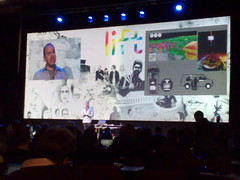 Finally in this track: Paul Dourish, an AI researcher.
Finally in this track: Paul Dourish, an AI researcher.
When we think about ethnography as a way to understand things we should build, as a form of market research, we miss its grounding as an analytic process.
What's mobility, from the perspective of tech design? Location, localisation, mapping, coordinates, longitude, services.
From an ethnographic perspective, it'd be home, diaspora, pilgrimage, colony, asylum, migration, nomad. Drawing on this, a couple of pieces done by anthropologists (not by anyone working within tech companies or with any regard to technological interventions):
First, aboriginal navigation: presence or absence of people from a landscape. Places from which people are excluded or exclude themselves. Patterns of navigation can't be divorced from concerns like, who you are, in this context - e.g. you need to take into account sacred sites and the imprint of historical or mythic actions that have occurred there. Ritual exclusions stop mothers-in-law and sons-in-law from meeting, say: the presence of certain others stops you from being there. Sometimes you can only tell the significance of a space by the absence of others from it.
Second, Lisa Malkki of Stanford about Hutu refugees living in Tanzania, looking at how they thought of their identity as refugees. You might consider this as a negative identity, but refugee status was valued and projected as a sign of the refusal to become naturalised to a place where they didn't belong. Clinging to refugee status claims an ethnic identity distinct from geographical status.
Third, paroled sex offenders tagged by location and excluded from certain places by conditions of their parole. There's a series of resonances between their situation and the claims of Malkki around presence and location; and with the aboriginal study and the implications of absence from space. Sex offenders are unusual in that they have abrogatd their social rights to privacy.
LIFT 2008: Sustainable development
February 07, 2008 | CommentsBill Thompson and Philippa Martin-King talking about sustainability.
BT: It's not about carbon load, it's about availability of voltage differences. There's a link between electricity and carbon, but carbon is not the problem... ICT systems were designed in a time before environmental issues, they're not efficient... We need to take small steps to improve our efficiency so we can justifiably approach governments and corporations and ask them to change.
PMK: It's today's youth who will be dealing with the problem.
<Tom Taylor on using social softwar to encourage sustainable behaviour:
It's clear that our behaviours are unsustainable. 88% of people are concerned, most have problems finding things that they can do to help beyond recycling.
www.dothegreenthing.com - a social site around setting up monthly actions in which to participate. Badges of green actions individuals have carried out. It's a hook: doing something easy gets you into the site, which then moves you on to do harder things. (Very reminiscent of another startup we've been talking to recently.)
Namechecks Nike+, Wattson, iPhone interface for monitoring electricity usage in your house (using Bluetooth plug sockets).
"It needs to be positive, fun and easy".
Next, Guy Pignolet from Sunsat Energy Council on solar energy capture.
We have plenty of energy coming to us from the sun. Maybe we need not more energy, but better energy - getting it in a more controlled way: from storms, waves, etc. We don't just need energy, we need controlled energy.
Japanese project: SSPS by Mitsubishi transports energy capture by sunlight using satellites to the earth by microwave: generate solar power in orbit. All the science exists now.
"We need a solar panel in space the size of Manhattan". So these are expected to be operational 30-40 years from now.
Second part: hydrogen. Batteries are poor, we don't know how to store electrocity - it has to be used when it's produced. Most of the universe is hydrogen.
...oop, battery low...
LIFT 2008: Stories
February 07, 2008 | Comments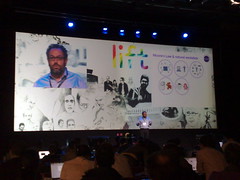 First up, Rafi Haladijan of Violet (manufacturers of Nabaztag):
First up, Rafi Haladijan of Violet (manufacturers of Nabaztag):
Violet was founded in 2003; Rafi started with Minitel.
Today, the ratio of information to available time is increasing rapidly. We have a limited amount of attention, and screens require an exclusive attention span. So the idea was to explore other ways of providing information.
In the beginning silicon was expensive: one computer, many users. Later cheaper: one computer, one user. Now: many computers, one user. Teddy bears talk nowadays; scales have gone from analogue to digital. All sorts of people are going digital, just to innovate (not necessarily because it's better). When Wi-fi gets cheap enough, we'll have communicating versions of all these objects.
"House of the future" projects have been talked around for years, but never happened. Why? It's not that appealing - it's no fun, and it implies a lack of control: people become strangers in their own home.
(Sounds to me like this mirrors the promise vs the reality of ubicomp)
Violet's strategy: do cheap $20-200 products with one-at-a-time buying decisions. Don't make it too useful - useful things are boring. Fun and interpersonal communication are as powerful propositions as usefulness.
First product, 2003: DAL Lamp, connected to the internet and changing lights depending on various events (network, weather, etc.). You could SMS it "I love you", and the lamp would turn red and start pulsating. People really liked this feature.
2005: Nabaztag.
December 2006: Nabaztag/tag! "The inconvenience of the name is part of the story - this is not technology as usual"
Why a rabbit? There was a rabbit on his desk the day they were thinking about it. They wanted to show it wasn't just another gizmo, they wanted to surprise people. "This absurd demonstration was important".
Nabaztag provides non-intrusive information with light and audio. Good for short reports, reading RSS feeds: things that are good to know but not worth the effort. Facebook status changes would be another good example of these.
Your friends can make it move - it's a "stringless puppet". You can marry it to someone else's rabbit. People feel they aren't moving bits, they're moving atoms. "This feeling of controlling things is more powerful when you move atoms not bits".
Important: it works even when the computer is turned off. It's not reliant on or connected to the users PC.
Last Christmas, they launched a joint offer with Gallimard Jeunesse: a childrens book with an RFID tag. Put the book near the rabbit and the rabbit starts reading it. Beautiful! It's a consumer application, it's RFID but not security, tracking or logistics-based; a demonstration that consumer RFID apps can be built.
Next generation will allow parents to record their own stories in their own voices, and share these readings with other parents: community and network building.
Also launching zstamps: RFID tags disguised as stamps that can be purchased and stuck to everyday objects, then use these to trigger interactions. They want ALL things to be connected. References book "Material World".
Absolutely cracking stuff :)
Now, Eric Favre, the co-inventor of Nespresso: "reinventing individual coffee consumption".
First inventors were Greeks, starting out with philosophy. Leonardi da Vinci then mixed science and art. Mr Eckhert was another 1940s inventor. It's pointless to invent without thinking of the client. He invented the first computer: 18 tonnes, 20 thousand lights, etc.
[ Finding watching this and listening to translation on headset whilst blogging not too easy... so will hold off now ]
"Cost them 400,000 euros to get a decent worldwide pattern. You have an idea and think 'everyone must have had this idea'. You find a hundred people who nearly got there.
"Tea is an essential product that's never had any evolution since the tea bag"
Finally, Jasmina Tesanovic, a Balkan political activist. During Serbian war, electronic communications was disrupted by the war, NATO blocking electronics, etc. In April 2006 the B92 internet site (which Jasmina works on) opened "VIP Blog" with authors living worldwide. The country is still run by spies, former mafia, ex-terrorists and moguls. When dissidents started blogging, this opened a new space in the political scene, making society more transparent.
B92 remains an important point of contact for Serbian expats. In South Africa the Truth & Reconciliation process brought everything out into the open, in Serbia a similar process has never happened - it's all been swept under the carpet.
And now the open stage session. First up, Noel Hidalgo, "on the luck of seven":
He offered to write a creative commons childrens book for $11.11 and has been travelling the world free on the back of that.
We don't live in a free society, but we want to. He left on 7/7/7 with a budget of $7,777, to see the 7 wonders of the world, dive in 7 numbers. 7 sits in every philosophy, religion, etc. He went off to explore 7 topics of freedom. There are 7 great lessons.
More here
And then Markus Peschl on "Enabling Emergent Innovation":
Innovation typically involves creating large numbers of ideas and then selecting from these. In most cases the decision becomes quite irrational. How do you leave the old behind to create a space for the new to emerge?
Innovation needs social and cognitive elements.
LIFT 2008: Online Environments
February 07, 2008 | Comments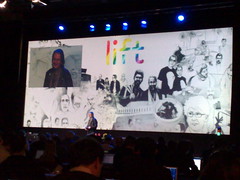 LIFT 2008: Online Environments
LIFT 2008: Online Environments
First up, Bruce Sterling. "2008 is not going to be a pivotal year. It's a crap year."
"Even in the tech world, is it really exciting to watch Microsoft eat Yahoo!? It's an aging monopoly shoring up its position by feeding on the week. Microsoft is so boring Gates left - he'd rather cure malaria."
A phenomenon we will be confronted with in 2008: Carla Bruni! Sarkozy met her at a French tech summit, where DRM was discussed. Carla is an artist and a copyright owner. They are the product of an "internet policy romance".
[...Bruce rambles about them some more...]
"90% of success is showing up... surviving to see the future"
I found this one pretty disappointing, but I'm hoping it was intensely clever and I just didn't get it (wouldn't be the first time).
Next: Pierre, Bellanger, CEO Skyrock (French media group). "The social network: future of telecommunications".
Skyrock radio: 3.7m listeners/day, 13-24yo.
Skyrock.com: blog platform, 2nd largest French site when measured by page views. First French-speaking social network. 21m accounts, 13.5m blogs, >500m posts, >1.7b comments. 90% of users are French-speaking. Aspiration: to be the worlds social network for kids (quite contended, that one).
He just said "netamorphosis". And Christ wept.
"Social networks are for mail what search is for the web" - cute.
All electronic exchanges hang off digital identity. Social network profiles rather than names are being used for this. Profiles are apparently enriched by personal data!
"value is shifting from bandwidth to code"
"the code is tomorrow's social network"
"the mobile phone is rapidly evolving into a pocket-sized internet terminal"
"the terminal is always on and always with you"
"What's the bridge between social networks and mobile? It's certainly not trying to put a web page on a mobile phone: it's instant messaging."
They're going to merge instant messaging and social networks into a "social messenger".
He just said "Social Operating System", moving from actually making any sense through to "chucking technical terms into a talk to sound a bit 2.0" IMHO.
Now mobiles are apparently good for controlling PCs - they'll be used as terminals. Fantastic idea - simultaneously giving the PC an awful input device and tethering the mobile to a single location, killing its primary advantage OVER EVERYTHING ELSE.
"mobile cloud computing - each mobile device is a server, and maybe a phone"
I don't know, perhaps I'm being a bit cruel (and kudos to anyone who can present well in a language other than their native tongue - I can barely converse in English) but this was trite-tastic and chock full of buzzwords.
I'm quite close to the topic having worked on several large mobile social software projects over the last few years, but this talk seemed quite vapid to me, I didn't get anything new from this talk. I'd expect a LIFT audience to have gotten the idea that social networking and mobile might have been brought together or have some relationship that predates current social networking hysteria.
Next: Jonathan Cabiria on Permeability: Real Life + Virtual Life = One Life
Psychologist, spent the last year looking at how participation in virtual worlds affects real life.
"The self is not something that one finds - it is something that one creates" - Thomas Szasz
We have many different identities (conscious and unconsciously) - evolutionarily speaking, for survival. If we present others with a facet of our identity they don't like, we get marginalised. If we don't fit in, we over-assert our identity ("fuck you, this is who I am"), or repress (cloak ourselves with an identity affect of the society to which they wish to belong) and hide.
Suppressing identities has severe psychological effects ("living an inauthentic life"). Virtual communities can assist here: finding a community of similar others affected self-esteem and translated back into the real world.
In our language we divide the real and virtual; but to some it's not real life or second life, it's all one life.
What does this mean for developers of social environments? We're always looking for ways to solidify our place in society.
Interesting talk, I wish it had been a bit longer and he'd gone into some recommendations for developers....
Next, Stephanie Booth: "Going solo, being a freelancer in a connected world".
2 years ago she was a middle-school teacher, left work. At first "people paid me for things that didn't feel like work". Started thinking about pricing, hired accountant. Realised she wasn't that great at negotiation. Trick to set day rates: work out monthly income desired, divide by number of days you will actually work. People don't pay for time, they pay for expertise. She's organising a conference for freelancers.
Can I write "sweet" without sounding patronising? Probably not. Shame.
Now Ewan McIntosh: "How social media creates social education"
Another former teacher. Works with Scottish govt on social media. Shows this video - notice lack of reaction from her mother in the background, who clearly doesn't care her daughter is breaking the world record :)
What makes good schools? Good teachers.
They started out with 20 teachers sharing their classroiom experiences, within a few months they had 350. They now have 1300 students and teachers blogging. They have kids doing video, podcasting, filmmaking, too. The community even created safety guidelines together (on a wiki?).
In 19th century, average audience for childrens work was 1 person. It's still the same - the teacher - despite advances elsewhere.